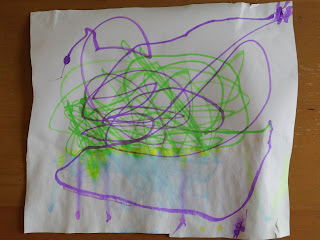We've tried
felt tip pen chromatography before and my son was pretty unimpressed, although he enjoyed it more when we
used the results to make a butterfly craft. I thought we could have another go and see if I could make it a little more exciting by using highlighter pens. The basic idea is that different inks have different solubility in water and therefore move different distances up the paper. Where the ink in a pen is a mixture, you can usually therefore see the constituent colours.
 |
| The intended result |
Highlighter pens are fluorescent, which means that they absorb ultraviolet (UV) light and emit light in the visible spectrum. The fluorescent inks therefore glow brightly when illuminated with UV light. I
made a UV light box from a cardboard box, some paper and a UV torch which makes it hard for children to accidentally look at the bright UV light which isn't good for their eyes. Along with various other cardboard contraptions which litter our house, this one is still around and I put the torch back in to use!
I tried to get my son to draw a row of different coloured dots on a piece of paper for the chromatography, but he opted for some more creativity in addition to a smattering of dots! I decided that we could compare the end results if I made a neat row of dots and we used both...
 |
| My son's "row of dots" |
We rolled the paper into a cylinder and put them into a little water (preferably below the level of the ink so that it doesn't soak out into the water) in an empty large yoghurt pot. My son continued with some more highlighter artwork whilst we watched the ink colours start to move up the page. They had very different solubilities with the purple barely moving (which also explains why it was tricky to clean it off the table with just water afterwards...).
 |
Chromatography in progress
|
We left them for about 15 minutes, then took them out to dry. Learning from our butterflies where the felt tip pen colours faded in the sunshine, we dried them inside which took quite a long time and I thought they were still too wet and easily ripped at the end of the day so they dried more overnight. The next day was busy and they were forgotten about for a few days, but eventually we put them in the UV light box. The yellow ink is the most fluorescent, and on my row of dots, it was easy to see how this had separated from the blue in the green highlighter pen. The orange pen also glowed, but interestingly this ink was a lot less soluble than the yellow and had stayed in its original location - I'd thought the orange may have been a mixture of dyes but it seems to be a single coloured ink.
 |
| After some of the ink has migrated |
On my son's drawing, there was a line of yellow where the water had reached, with the yellow showing brightly in the yellow and green drawing above the line. The purple drawing was pretty unchanged by the water. My son seemed to quite like the effect on his artwork and enjoyed seeing the fluorescence again - he experimented with pushing his picture different distances inside the box to see where the UV light reached and made the ink fluoresce.
 |
| Fluorescent inks |
I suspect with a higher quality set of highlighter pens you may find that there are more fluorescent dyes and more interest for children. We'll give it another go sometime, maybe when my younger son is old enough to appreciate it too! In the meantime I will probably liven up some mark-making/writing practice by using highlighter pens so my son can see his creations glow!
Comments
Post a Comment
All comments are moderated before being published.